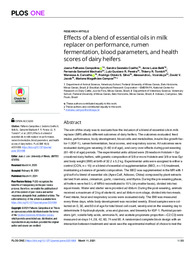Effects of a blend of essential oils in milk replacer on performance, rumen fermentation, blood parameters, and health scores of dairy heifers.
Effects of a blend of essential oils in milk replacer on performance, rumen fermentation, blood parameters, and health scores of dairy heifers.
Author(s): CAMPOLINA, J. P.; COELHO, S. G.; BELLI, A. L.; MACHADO, F. S.; PEREIRA, L. G. R.; TOMICH, T. R.; CARVALHO, W. A.; SILVA, R. O. S.; VOORSLUYS, A. L.; JACOB, D. V.; CAMPOS, M. M.
Summary: The aim of this study was to evaluate how the inclusion of a blend of essential oils in milk replacer (MR) affects different outcomes of dairy heifers. The outcomes evaluated: feed intake, performance, body development, blood cells and metabolites, insulin-like growth factor-1 (IGF-1), rumen fermentation, fecal scores, and respiratory scores. All outcomes were evaluated during pre-weaning (4?60 d of age), and carry-over effects during post-weaning (61?90 d of age) periods. The experimental units utilized were 29 newborn Holstein × Gyr crossbred dairy heifers, with genetic composition of 5/8 or more Holstein and 3/8 or less Gyr and body weight (BW) at birth of 32.2 ± 5.2 kg. Experimental units were assigned to either a control (CON, n = 15) or a blend of essential oil supplementation (BEO, n = 14) treatment, maintaining a balance of genetic composition. The BEO was supplemented in the MR with 1 g/d/calf of a blend of essential oils (Apex Calf, Adisseo, China) composed by plant extracts derived from anise, cinnamon, garlic, rosemary, and thyme. During the pre-weaning phase, all heifers were fed 5 L of MR/d reconstituted to 15% (dry matter basis), divided into two equal meals. Water and starter were provided ad libitum. During the post-weaning, animals received a maximum of 3 kg of starter/d, and ad libitum corn silage, divided into two meals. Feed intake, fecal and respiratory scores were evaluated daily. The BW was measured every three days, while body development was recorded weekly. Blood samples were collected on 0, 30, and 60 d of age for total blood cell count, weekly and on the weaning day to determinate ß-hydroxybutyrate, urea and glucose, and biweekly for IGF-1. Ruminal parameters (pH, volatile fatty acids, ammonia-N, and acetate:propionate proportion?C2:C3) were measured on days 14, 28, 42, 60, 74 and 90. A randomized complete block design with an interaction between treatment and week was the experimental method of choice to test the hypothesis of the BEO?s effect on all outcomes. An ANOVA procedure was used for continuous outcomes, and a non-parametric test was used for the ordered categorical outcomes, both adopting a CI = 95%. Results indicated that there was not enough evidence to accept the alternative hypothesis of the effect of BEO in MR on feed intake, performance, body development, and blood metabolites during both pre-weaning and post-weaning periods. However, results indicated that the inclusion of BEO in MR significantly affects the proportion of C2:C3 during pre- and post-weaning (P = 0.05). Similarly, the effect was significant for basophil (P menor igual 0.001), and platelet (P = 0.04) counts pre-weaning. The interaction between week and treatment was also significant for lymphocytes (P menor igual 0.001), revealing a cumulative effect. Lastly, fecal scores were also significant (P = 0.04) during pre-weaning, with lower values for BEO. The BEO contributed to ruminal manipulation in pre-weaning and carry-over effects in post-weaning, immunity improvement, and decreased morbidity of neonatal diarrhea in the pre-weaning phase.
Publication year: 2021
Types of publication: Journal article
Unit: Embrapa Dairy Cattle
Keywords: Fermentação Lática, Leite, Novilho Leiteiro, Rúmen
Observation
Some of Embrapa's publications are published as ePub files. To read them, use or download one of the following free software options to your computer or mobile device. Android: Google Play Books; IOS: iBooks; Windows and Linux: Calibre.
Access other publications
Access the Agricultural Research Database (BDPA) to consult Embrapa's full library collection and records.
Visit Embrapa Bookstore to purchase books and other publications sold by Embrapa.

